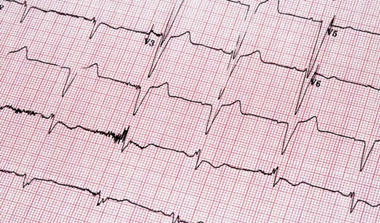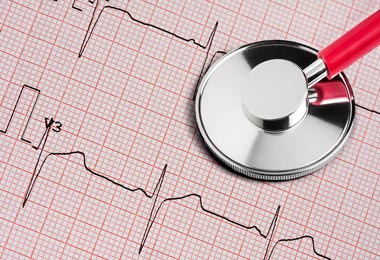Chemical Cardioversion
What is chemical cardioversion?
Cardioversion is a procedure used to return an abnormal heartbeat to a normal rhythm. It's used to treat a very fast or irregular heartbeat (arrhythmia). In chemical cardioversion, medicines are used to get the heart back to a normal rhythm. It's different from electrical cardioversion. This is where an energy shock is used to bring back a normal heart rhythm.
Normally, a special group of cells start the electrical signal of your heartbeat. These cells are in the sinoatrial (SA) node in the upper right chamber of the heart (right atrium). The signal quickly travels down the heart’s conducting system on its way to the ventricles, the two lower chambers of the heart. As it travels, the signal triggers nearby parts of the heart muscle to contract. This helps the heart contract in a controlled way.
Many problems can upset the signaling pathway and lead to abnormal heart rhythms. The heart might beat very quickly. As a result, the heart doesn't have enough time to fill with blood between beats. This can keep your heart from pumping enough blood to the body. Some abnormal heart rhythms may raise your risk for stroke. Some also raise the risk for life-threatening rhythms that can lead to sudden death. Cardioversion upsets the abnormal signaling. It allows the heart to reset itself back into a normal rhythm, like when you reboot your computer to reset it.
Why might I need a chemical cardioversion?
Chemical cardioversion can help to treat a number of different abnormal heart rhythms. It's sometimes used to treat atrial fibrillation (AFib). With this condition, the atria of the heart quiver instead of contracting correctly. People with AFib may have shortness of breath, fatigue, and a very fast heartbeat. They are also at increased risk for stroke.
Your healthcare provider may suggest some type of cardioversion if this is your first episode of AFib. They may also advise it if you have constant AFib especially with severe symptoms. Your healthcare provider may try a chemical cardioversion first. You don't need sedation and the procedure is less upsetting than an electrical cardioversion. If this treatment does not work, your healthcare provider may do an electrical cardioversion. It's more likely the electrical shock will work after you have tried chemical cardioversion.
Chemical cardioversion can also help treat other abnormal heart rhythms. These include atrial flutter, supraventricular tachycardias, and ventricular tachycardia (VT). All these heart rhythms can cause heart rates that are too fast. This can prevent the heart from pumping enough blood.
If your symptoms are mild, your healthcare provider may suggest that you not have cardioversion. They may also advise against it if you have had AFib for a long time. It may also not be advised if you are an elderly adult or have other major health problems. Other treatments might be better for you. These include heart rate control with medicines.
Before trying chemical cardioversion, your healthcare provider may try to reset the heart rate in other ways. This might include the Valsalva maneuver. This is a method where you hold your breath and increase the pressure in your belly. This can help slow down the heart rate. Your healthcare provider may then use chemical cardioversion to change your rhythm to normal. If these things don’t work, electrical cardioversion is often the next step.
What are the risks of chemical cardioversion?
Although many people have a successful chemical cardioversion, the procedure has certain risks. Your own risks may differ based on your age, the type of abnormal heart rhythm you have, and your other medical conditions. Ask your healthcare provider about the risks for you.
In rare cases, a chemical cardioversion can cause a new, more dangerous heart rhythm. If that happens, you will get medicines or an electric shock to stop this rhythm. Some additional risks include:
-
Increased frequency of the original abnormal rhythm
-
Dislodged blood clot (which can cause stroke or other problems)
-
Slow heart rate
-
Low blood pressure
Each of the medicines used in chemical cardioversion has risks and possible side effects. Ask your healthcare provider about the risks of the medicines you will be using.
A medicine called an anticoagulant or blood thinner may be given before and after the procedure. This medicine helps to reduce your risk of blood clots, especially if you have atrial fibrillation or flutter.
In some cases, the cardioversion may not restore a normal heart rhythm. Or, you might go back to your abnormal rhythm shortly after your cardioversion.
How do I get ready for a chemical cardioversion?
Talk with your healthcare provider about what you should do to get ready for your chemical cardioversion. Follow your healthcare provider’s instructions about what medicines to take before the cardioversion. Don’t stop taking any medicine unless your healthcare provider tells you to do so. You might need blood tests before the procedure to make sure it's safe to have the procedure.
Depending on the type of irregular heart rhythm you have, you could be at a higher risk of blood clots. Your healthcare provider may want you to take blood thinner medicine for several weeks before and after your cardioversion. This is to help prevent blood clots. Your healthcare provider may also want you to have a transesophageal echocardiography test before the procedure. This test is a special kind of ultrasound. A thin, flexible tube is put down your throat and into your esophagus (the channel that carries food from your mouth to your stomach). Here, the tube is close to your heart. It lets your healthcare provider see if you have any blood clots in the chambers of the heart.
If a clot is found, your healthcare provider may delay the cardioversion for a few weeks. You’ll likely take blood-thinner medicine for a while until your healthcare provider thinks your risk of clots is low. You are also likely to need blood-thinner medicine if your abnormal rhythm has lasted more than 48 hours. This is also true if you have had a blood clot in the past. Be sure to take this medicine exactly as your healthcare provider tells you.
What happens during a chemical cardioversion?
The procedure will be done in a hospital for the first attempt at chemical cardioversion so that the heart rhythm can be continuously monitored. If the first time is successful and without complications it may then be done in a healthcare provider’s office or in your home depending on the medicines being used. Your healthcare provider will give you an antiarrhythmic medicine. This is given by mouth or through an IV line. If you are treated at home, you will need careful follow-up with a cardiologist. If you have chemical cardioversion at a hospital, someone will check your heart rate and rhythm, and blood pressure.
The type of medicine used will vary based on your type of abnormal rhythm and your other health problems. The following are some examples of medicines that your healthcare provider might use:
-
Flecainide, dofetilide, propafenone, amiodarone or ibutilide, for AFib
-
Adenosine, verapamil, diltiazem, metoprolol for supraventricular tachycardia, (SVT)
What happens after a chemical cardioversion?
Sometimes chemical cardioversion works very quickly. Other times, it may take hours to work. In rare cases, it may take up to a few days to work. In some cases, you may need an electrical cardioversion if the chemical cardioversion did not work.
Your healthcare provider may want to check your heart rhythm for a period of time after you have been given the medicine. Ask your healthcare provider about the possible side effects of the medicine used in your chemical cardioversion. Be on the lookout for these side effects. Tell a healthcare provider right away if these side effects are bad. Call a healthcare provider right away if your symptoms get worse.
Next steps
Before you agree to the test or procedure make sure you know:
-
The name of the test or procedure
-
The reason you are having the test or procedure
-
What results to expect and what they mean
-
The risks and benefits of the test or procedure
-
What the possible side effects or complications are
-
When and where you are to have the test or procedure
-
Who will do the test or procedure and what that person’s qualifications are
-
What would happen if you did not have the test or procedure
-
Any alternative tests or procedures to think about
-
When and how you will get the results
-
Who to call after the test or procedure if you have questions or problems
-
How much you will have to pay for the test or procedure





